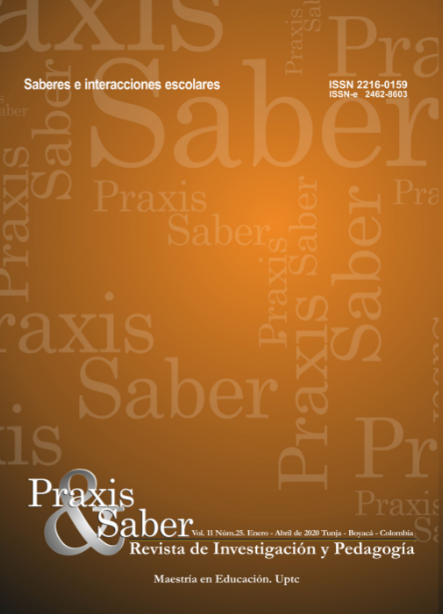Naturalist intelligence: effects on critical thinking and needs for cognition

Abstract
A pedagogical program based on the improving of naturalist intelligence on the development of critical thinking skills and needs for cognition in fourth-grade students of a public school in Bogotá is analyzed. The study involved 99 students belonging to three intact groups: two of them are experimental and one is the control group. The methodology follows the quantitative approach. The differences of groups were contrasted through the Student's t-test. Moreover, the relation between variables was determined from the Spearman correlation coefficient, ρ [rho]. As instruments for the collection of information, both the Halpern HCTAES test and the need for cognition test were used, with measurement in two moments: one before the experimental treatment—pre-test—and the other one once the training program in naturalist intelligence finished—post-test. The intervention adopted as a pedagogical approach was the problematic teaching proposed by Majmutov. The results show changes in both the experimental and the control groups. They also show a positive correlation between the variables considered: training in naturalist intelligence and the increase in critical thinking skills; as well as their relation with the previous existence of needs for cognition.
Keywords
naturalist intelligence, critical thinking, need for cognition, primary student, pedagogical program
References
Aznar, I., & Laiton, E. (2017). Desarrollo de habilidades básicas de pensamiento crítico en el contexto de la enseñanza de la física universitaria. Formación Universitaria, 10(1), 71-78. https://doi: 10.4067/S0718-
50062017000100008
Beltrán, M., & Torres, N. (2009). Caracterización de habilidades de pensamiento crítico en estudiantes de educación media a través del test HCTAES. Zona próxima. Revista científica de la Universidad del norte,
11(12). Recuperado de http://rcientificas.uninorte.edu.co/index.php/zona/article/viewArticle/1595/4661
Cacioppo, J,, & Petty R. (1982). The need for cognition. Journal of personality and social Psychology. 42(1). PP. 116-131. Recuperado en: https://academic.csuohio.edu/kneuendorf/quillin/cacioppo%20petty%20the%20need%20for%20cognition%201982.pdf.
Cacioppo, J., Petty, R., & Kao, C. (1984). The Efficient assessment of Need for Cognition. En Journal of Personality Assessment 48 (3). PP. 306 – 307.
Ceolin, S., González, J., Ruiz, M., & Heck, R. (2017). Bases teóricas del pensamiento crítico en la enfermería iberoamericana: Revisión integrativa de la literatura. Texto contexto Enferm, 26(4), 1-13. https://doi:10.1590/0104-07072017003830016
Clifford, B. (1980). Voices Identification by Human Listeners: On Earwitness Reliability, en Law and Human Behavior 4 (1), 373-394.
Facione, P., & Facione, N (1992). The California critical thinking dispositions inventory (CCTDI); and the CCCTDI test manual. Millbrae, C.A: The California academic press.
Facione, P. (1990). Critical thinking: A statement of expert consensus for purposes of educational assessment and instruction. Millbrae, CA: The California Academic Press.
Febres, M., Pérez, A., & Africano, B. (2017). Las pedagogías alternativas desarrollan el pensamiento crítico. Educere, 21(69), 269-274. Recuperado de http://www.redalyc.org/jatsRepo/356/35655222005/index.html
Fisher, A. (2008). Critical Thinking: An Introduction. Cambridge: Cambridge University
Gallego, A., Castro, P., Montaña, J., & Rey, J. (2008). Pensamiento científico en los niños y las niñas: algunas consideraciones e implicaciones. Recuperado de http://portalweb.ucatolica.edu.co/easyWeb2/files/44_198_v2n3gallego.pdf
Gardner, H. (2001). Estructuras de la mente. México: Fondo de Cultura Económica.
Gómez, D. (2015). Diseño, aplicación y evaluación de un programa educativo basado en la competencia científica para el desarrollo del pensamiento crítico. (Tesis doctoral, Universidad Autónoma de Madrid,
Madrid, España). Recuperado dehttps://repositorio.uam.es/bitstream/handle/10486/668574/albertos_gomez_daniel.pdf?sequence=1
Gulgoz, S., & Sadowski, C. (1995). Turkish adaptation and correlation of the need for cognition scale with the indices of student success. Turkish Journal of Psychology, 10(1), 15-24.
Halpern, D. (1996). Thought and knowledge: An introduction to critical thinking. Hillsdale, N.J.: Erlbaum.
Halpern, D. (2006). Halpern critical thinking Assessment Using Everyday Situations: Background and scoring standards (2° report). Unpublished manuscript claremont, CA: Claremont McKenna College.
Halpern, D. (2009). Thoght & Knowledge. New York: Erlbaum Associates.
Harlen, W. (2005). Cómo ayudar a los profesores a utilizar la evaluación para el aprendizaje en la ciencia basada en indagación. Recuperado en http://www.senacyt.gob.pa/madia/documentoshagamosciencia/carulla2008panamaforo.pdf
Jaimes, A., & Ossa, C. (2016). Impacto de un programa de pensamiento crítico en estudiantes de un liceo de la Región del Biobío. Revista de Investigación Educacional Latinoamericana, 53(2), 1-11.
Kabalen, D. (2012). Análisis y pensamiento crítico para la expresión verbal. México: Editorial Digital Tecnológico de Monterrey. Recuperado en: https://www.editorialdigitaltec.com/materialadicional/ID371_Kabalen_Analisisypensamiento.cap1.pdf
Lipman, M. (1990). Pensamiento complejo y educación. Madrid. Ediciones de la Torre Recuperado en: https://carbonilla.files.wordpress.com/2010/04/lipman.pdf
Majmutov, M. (1983) La enseñanza problémica. La Habana: Editorial Pueblo y Educación.
McMillan, J. (1987). Enhancing college student’s critical thinking: A review of Studies. Research in higher education, 26(1), 3-29. Recuperado de https://link.springer.com/article/10.1007/BF00991931
McPeck, J. (1981). Critical thinking and education. Oxford: Martin Robinson. Recuperado en: http://journals.sagepub.com/doi/pdf/10.3102/0013189X018009021
Ministerio de Educación Nacional. (2006). Estándares básicos de competencias en lenguaje, matemáticas, ciencias y ciudadanas: guía sobre lo que los estudiantes deben saber y saber hacer con lo que aprenden. Bogotá: Imprenta Nacional de Colombia.
Moreno, P., & Velásquez, M. (2017). Estrategia didáctica para desarrollar el pensamiento crítico. REICE Revista Iberoamericana sobre calidad, eficacia y cambio en la Educación, 15(2), 53-73. Recuperado de http://www.redalyc.org/articulo.oa?id=55150357003
Navarro, F., & Gómez, Z. (2015). El efecto del aprendizaje activo en el desarrollo de habilidades propias del pensamiento crítico en estudiantes de ciencias. Revista de Educación y desarrollo, 34(5), 1-10.
Norris, S. (1989). Can we test validly for Critical Thinking?. Educational Researcher, 18(9), 21-26. https://doi: 10.3102/0013189X018009021
Paul, R. (1993). Critical thinking: How to prepare students for a rapidly changing world. Santa Rosa, CA: Foundation for critical thinking.
Paul, R., & Elder, L. (2005). Estándares de competencias para el pensamiento crítico. Estándares, principios, desempeño, indicadores y resultados con una rúbrica maestra en el pensamiento crítico. Dillon Beach: Fundación para el pensamiento crítico.
Solanas, A., Salafranca, L., Fauquet, J., & Núñez, M. (2005). Estadística descriptiva en Ciencias del Comportamiento. Madrid: Thompson.
Swartz, R., & Perkins, D. (1990). Teaching thinking: Issues and approaches. Pacific Grove, California Midwest Publications. Recuperado de https://eric.ed.gov/?id=ED405697
Tamayo, A. (2014). Pensamiento crítico en el aula de ciencias. Manizales: Universidad de Caldas.
Torres, D., Villamil, P., & Pineda, B. (2017). Las vivencias como estrategia de fortalecimiento del pensamiento crítico en educación rural. Praxis & Saber, 8(17), 201-224. https://doi: 10.19053/22160159.v8.n17.2018.7207
Trochim, W. (2006). The Research Methods Knowledge Base, (2a Ed). Recuperado de http://www.socialresearchmethods.net/kb/
